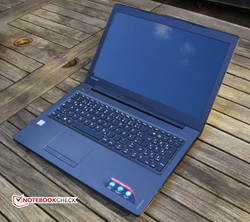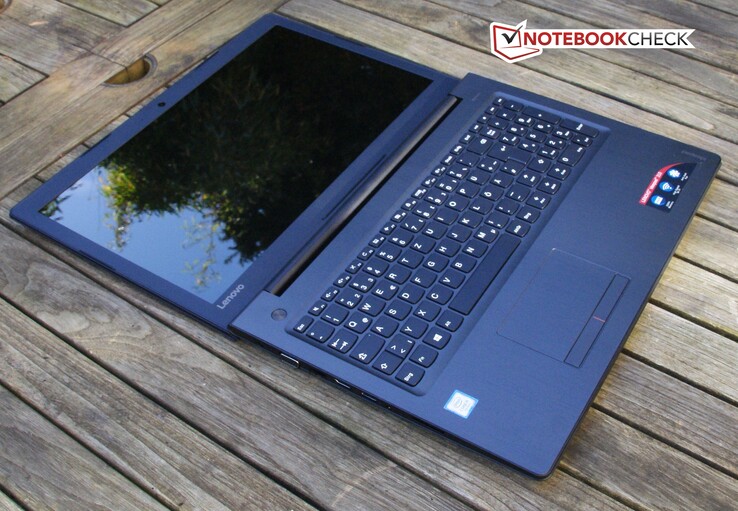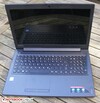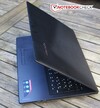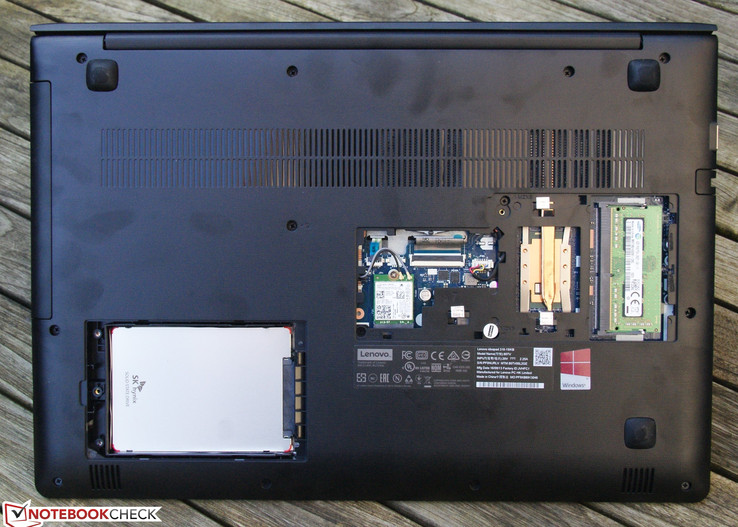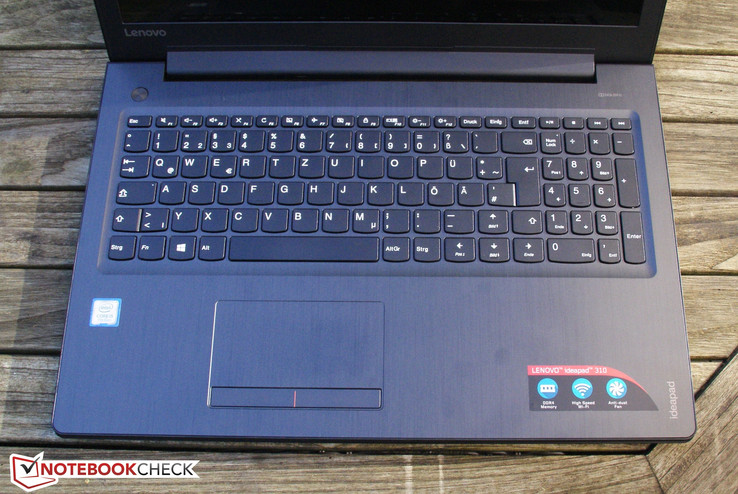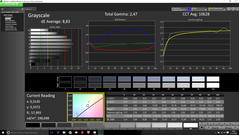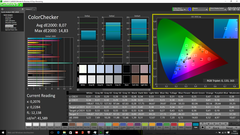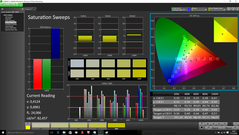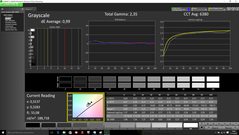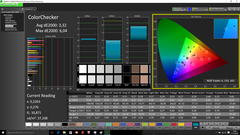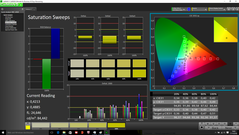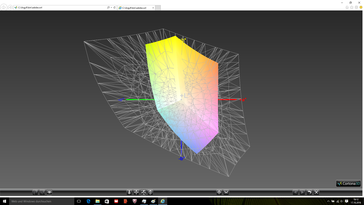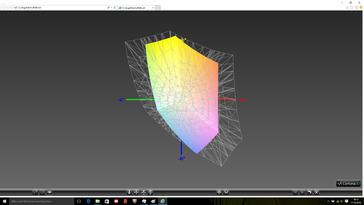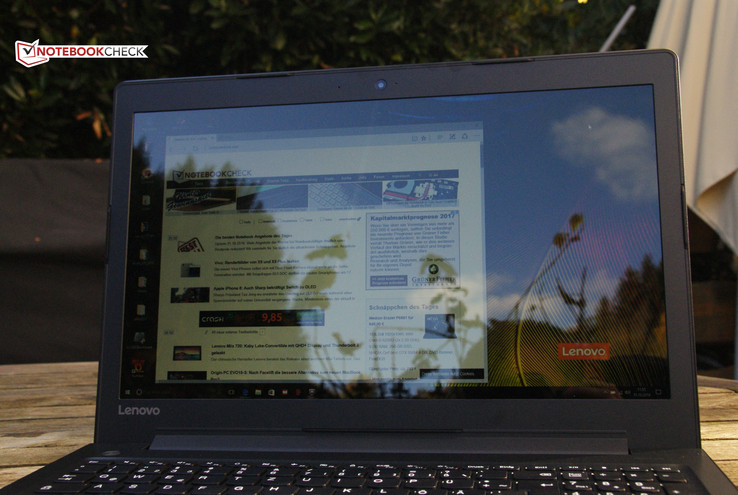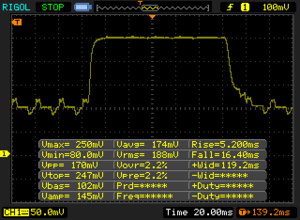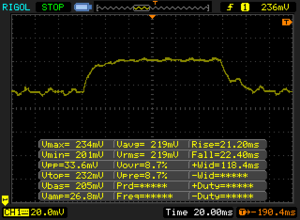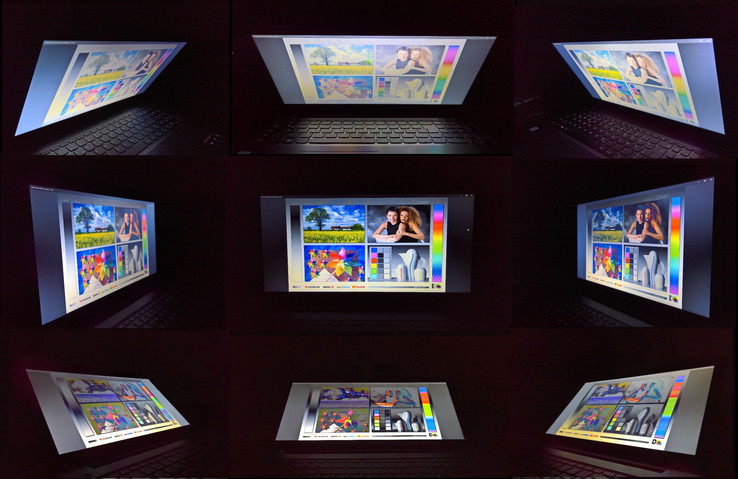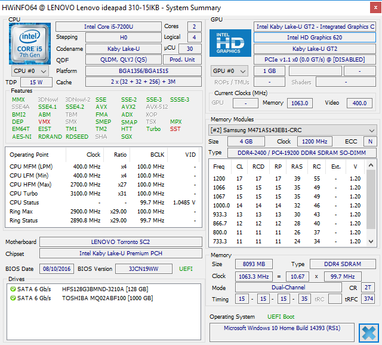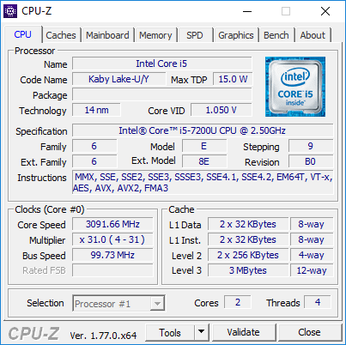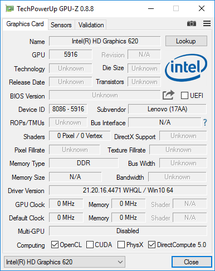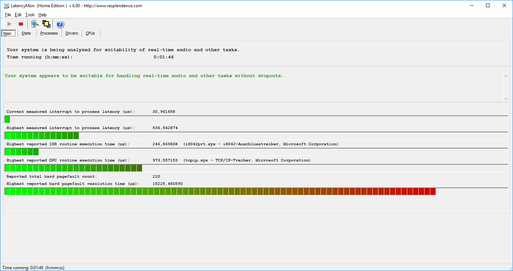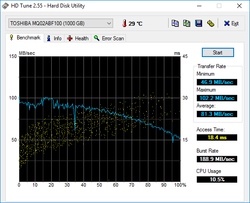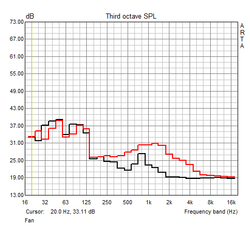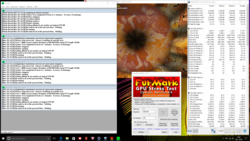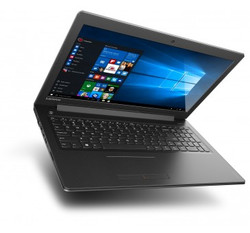Lenovo IdeaPad 310-15IKB Notebook Review

For the original German review, see here.
Despite the large variety of ultrabooks on the market, it seems the 15-inch form factor is the most popular for laptops. The recipe for a bestseller: cheap, as much RAM and storage space as possible, a large display and a Core i5 processor. The Lenovo IdeaPad 310-15IKB is one such model and we will be testing it our in-depth review. The 300 series represents the lower middle-class of the Lenovo IdeaPad series and is geared towards private users who want a cheap model. If the price is still too high, you might want to consider the even cheaper 100 series (the IdeaPad 100-15IBD).
Our test model is one of the first IdeaPads to come with the new Intel Kaby Lake CPUs. The notebook market for private users is making the switch to the new Intel processor generation, but this transition is just starting. As such, there are very few comparable devices which use a processor from this generation (see the Acer Aspire E5-575G). At the same time, there are models with a Kaby Lake processor which we have yet to test (like the HP 15-av102ng). As this category has so many models to offer, we will be selecting a few for comparison with our test model.
Case
The IdeaPad 310-15IKB has the same case as the IdeaPad 310-15ISK, which means it will share the strengths and weaknesses of it sister model.
The case is entirely black. The display cover and the base of the laptop are constructed with a rough plastic which is susceptible to fingerprints. In contrast, the hand-rest regions are made of a metallic-looking synthetic material, which is fine for this price segment. Thankfully, the display borders use matte plastic, which is a big improvement from the days of glossy borders.
The workmanship of the device is fine: there are no uneven gaps or sharp edges. However, the sturdiness is the same as that of the IdeaPad 310-15ISK: it could be better. Above the keyboard and the touchpad, the hand-rest regions can be bent inwards. The base is easy to bend and the display cover is wobbly. When we applied pressure to the latter, the screen showed distortions.
The single, wide drop down hinge does not allow the user to open the laptop with a single hand. Furthermore, the display will wobble in moving environments as the hinge does not force it in place.
The weight and measurements are typical for a 15.6-inch notebook. Despite the Ultrabook processor, the IdeaPad is a classic laptop.
All-in-all, Lenovo is offering a case which is appropriate for the price tag.
Connectivity
The usual suspects can be found on this laptop. We did not like the fact that there is only one USB 3.0 port on the test model. Furthermore, the model does not have USB Type-C. To be fair, it is rare to see this port in cheap laptops. We like the VGA interface, as it will allow users to connect VGA screens or beamers. However, this also limits the laptop, as it will not be possible for the user to use a 4K monitor at 60 Hz. This would only be possible with a DisplayPort and Lenovo uses the HDMI and VGA combo.
The placement of the ports also raises issues. The two USB 2.0 ports are placed poorly on the right side, as they are very close together and near the front. If you only have one USB device, you can stick with the USB 3.0 port on the other side. Otherwise, this placement is disadvantageous (especially for right-handed users), as it will create cable clutter at the front of the laptop and prevent the comfortable use of an external mouse. The Ethernet interface has a flap on it, which makes connecting a cable a clumsy operation.
SD-Card Reader
In the SD-card reader performance benchmark, we use the Toshiba Exceria Pro SDXC 64 GB UHS-II as a reference memory card. The benchmark revealed that Lenovo uses a very cheap and slow card reader in our test model. Obviously, the laptop is going to be far off from the great numbers posted by a high-end model, like the Dell XPS 13. However, the performance is so bad, that the user might have to consider using an SD card as a storage device only as a last possible option. Furthermore, the SD cards stick out a little, which will make them a less attractive long-term solution.
| SD Card Reader | |
| average JPG Copy Test (av. of 3 runs) | |
| Dell XPS 13 9360 FHD i5 | |
| Lenovo Ideapad 310-15IKB | |
| Acer TravelMate X3 X349-M-7261 | |
| maximum AS SSD Seq Read Test (1GB) | |
| Dell XPS 13 9360 FHD i5 | |
| Acer TravelMate X3 X349-M-7261 | |
| Lenovo Ideapad 310-15IKB | |
Communication
The WLAN performance is a little better. The Lenovo model uses a 1x1 Intel module: the Wireless-AC 3165. The performance is decent and we did not encounter any instability during our test. However, once again, it seems more money for a stronger Wi-Fi module might be the way to go: the Mi Notebook Air 13 is much faster while up-/downloading.
Thankfully, Lenovo has used a Gigabit Ethernet port from Realtek. Fast Ethernet is truly outdated.
| Networking | |
| iperf Server (receive) TCP 1 m | |
| Xiaomi Mi Notebook Air 13.3 2016 | |
| Acer Aspire E5-774-54HJ (jseb) | |
| Lenovo Ideapad 310-15IKB | |
| iperf Client (transmit) TCP 1 m | |
| Xiaomi Mi Notebook Air 13.3 2016 | |
| Acer Aspire E5-774-54HJ (jseb) | |
| Lenovo Ideapad 310-15IKB | |
Accessories
No additional accessories are included in the delivery and, aside from USB docks, the manufacturer is not offering any docking solutions. For laptops of this class and price, this is acceptable.
Maintenance
The IdeaPad 310-15IKB has two small maintenance flaps on the bottom. One hides the 2.5-inch HDD and the other larger flap secures the RAM modules and the WLAN device. To take off the flaps, the user must remove screws and small clips. We recommend using a plastic pry-up tool.
The hard-drive slot can also be removed by taking out one screw from the bottom and pulling on the module a little. Our model does not have an ODD, but rather an HDD/SSD caddy with an additional HDD. This will definitely interest techies.
The battery and fan are not accessible. The entire laptop must be taken apart to gain access to these parts. All-in-all, the IdeaPad 310-15IKB allows the user to easily maintain the "basic parts" of the laptop.
Warranty
The warranty of the IdeaPad 310-15IKB will last 24 months (12 months for the battery). This is a "Bring-In" service, which means the laptop needs to be sent to the manufacturer. The warranty can be changed or extended. For example, the user could add accident coverage so that the laptop is insured against drops. The warranty may be upgrade up to 36 months with on-site service, which means the service employee would repair the device in the shop directly.
Please see our Guarantees, Return Policies & Warranties FAQ for country-specific information.
Input Devices
Keyboard
The IdeaPad 310-15IKB is a 15-inch laptop with a wide chiclet keyboard, which includes a number pad. All keys are full-sized, including the cursor keys. This leaves little space for certain keys, such as the right Shift key which has been made smaller. If you use this key often, you might need to take some time to get acquainted with the size difference.
The keys have a comfortable stroke distance and typing feel. Lenovo has earned a reputation for providing the best keyboards. However, the IdeaPad is far from the ThinkPad level. Subjective: the laptop keyboard does not bend too much while typing. In fact, the keyboard only deforms under strong pressure, which makes it very similar to other cheap laptops.
A backlight or some other form of key lighting has not been provided.
Touchpad
The touchpad of the test model uses the same metallic-looking plastic as the hand-rest regions. The device is very smooth, which means the finger easily glides over it. The touchpad is very quick to respond and accurate. Sadly, it cannot match the qualities of a Microsoft Precision touchpad or a MacBook. Two-finger scrolling works quite well, but scrolling with a single finger might be a little laggy.
This is not a ClickPad: Lenovo has built in a single bar with two separate keys on each end. This is a poor solution, as the user will only be able to really press at the very far ends of the bar. Furthermore, the click mechanism is not great, as clicks feel hard and are barely audible. The manufacturer should either have gone with a ClickPad or a touchpad with separate mouse keys.
Display
Lenovo has installed an FHD display (1920x1080 pixels) in our test model. This is a cheap TN panel which offers significantly worse image quality in comparison to IPS screens. The display surface is glossy and it seems this is the only option Lenovo is willing to offer for the IdeaPad. A matte display or a panel with higher resolution is not available.
The display has poor brightness compared to most of the +300-Euro (~$316) models of 2016. At 188 cd/m2, the max brightness is very weak. Thankfully the brightness is distributed properly over the panel: 95% distribution. We did not notice any backlight bleeding or PWM-flickering.
In this price class, there are a few displays which offer better. The IdeaPad 510-15IKB is a natural competitor for our test model, as it is priced at 560 Euros (~$591) and offers an IPS panel. Usually, you have to pay more for an IPS panel: see the Dell Inspiron 15-5559 or the Acer Aspire V15 Nitro VN7-572G, which require at least 700 Euros (~$739). IPS displays are also relatively brighter, as shown in our comparison. Even the Acer Aspire E5-774 has a brighter TN FHD screen. At the very least, Lenovo has improved the screen of our test model since its predecessor.
| |||||||||||||||||||||||||
Brightness Distribution: 95 %
Center on Battery: 185 cd/m²
Contrast: 661:1 (Black: 0.28 cd/m²)
ΔE ColorChecker Calman: 8.07 | ∀{0.5-29.43 Ø4.77}
ΔE Greyscale Calman: 8.83 | ∀{0.09-98 Ø5}
57% sRGB (Argyll 1.6.3 3D)
36.2% AdobeRGB 1998 (Argyll 1.6.3 3D)
39.34% AdobeRGB 1998 (Argyll 3D)
57.3% sRGB (Argyll 3D)
38.07% Display P3 (Argyll 3D)
Gamma: 2.47
CCT: 10628 K
| Lenovo Ideapad 310-15IKB BOE NT156FHM-N31, , 1920x1080, 15.6" | Lenovo IdeaPad 510-15IKB 80SV0087GE BOE HF NV156FHM-N42, , 1920x1080, 15.6" | Acer Aspire E5-774-54HJ AU Optronics B173HTN01.1, , 1920x1080, 17.3" | HP 250 G5 SP X0N33EA AU Optronics AUO38ED, , 1920x1080, 15.6" | Medion Akoya P6670 LG Philips LP156WF6-SPK3, , 1920x1080, 15.6" | Lenovo Ideapad 310-15ISK LG Philips LP156WHU-TPG1, , 1366x768, 15.6" | |
|---|---|---|---|---|---|---|
| Display | 12% | 73% | -4% | 0% | -3% | |
| Display P3 Coverage (%) | 38.07 | 42.66 12% | 71.3 87% | 36.51 -4% | 38.14 0% | 37.06 -3% |
| sRGB Coverage (%) | 57.3 | 64.1 12% | 91.7 60% | 55 -4% | 57.2 0% | 55.8 -3% |
| AdobeRGB 1998 Coverage (%) | 39.34 | 44.08 12% | 67.1 71% | 37.72 -4% | 39.43 0% | 38.29 -3% |
| Response Times | -50% | -4% | 1% | -2% | 16% | |
| Response Time Grey 50% / Grey 80% * (ms) | 43 ? | 51 ? -19% | 42 ? 2% | 40 ? 7% | 42 ? 2% | 27 ? 37% |
| Response Time Black / White * (ms) | 21 ? | 38 ? -81% | 23 ? -10% | 22 ? -5% | 22 ? -5% | 22 ? -5% |
| PWM Frequency (Hz) | 50 ? | 1000 ? | 50 | 50 ? | ||
| Screen | 36% | 30% | -19% | 2% | -6% | |
| Brightness middle (cd/m²) | 185 | 291 57% | 353 91% | 219 18% | 287 55% | 200 8% |
| Brightness (cd/m²) | 184 | 265 44% | 320 74% | 222 21% | 269 46% | 198 8% |
| Brightness Distribution (%) | 95 | 86 -9% | 82 -14% | 85 -11% | 74 -22% | 83 -13% |
| Black Level * (cd/m²) | 0.28 | 0.23 18% | 0.38 -36% | 0.39 -39% | 0.65 -132% | 0.28 -0% |
| Contrast (:1) | 661 | 1265 91% | 929 41% | 562 -15% | 442 -33% | 714 8% |
| Colorchecker dE 2000 * | 8.07 | 4.78 41% | 5.07 37% | 12.67 -57% | 5.42 33% | 10.63 -32% |
| Colorchecker dE 2000 max. * | 14.83 | 9.51 36% | 10.12 32% | 20.99 -42% | 9.54 36% | 15.69 -6% |
| Greyscale dE 2000 * | 8.83 | 3.49 60% | 13.38 -52% | 13.82 -57% | 5.14 42% | 11.19 -27% |
| Gamma | 2.47 89% | 2.58 85% | 2.69 82% | 2.63 84% | 2.48 89% | 1.78 124% |
| CCT | 10628 61% | 6013 108% | 15991 41% | 15633 42% | 6952 93% | 11258 58% |
| Color Space (Percent of AdobeRGB 1998) (%) | 36.2 | 40 10% | 60.1 66% | 35 -3% | 36 -1% | 35 -3% |
| Color Space (Percent of sRGB) (%) | 57 | 64 12% | 91.6 61% | 55 -4% | 57 0% | 56 -2% |
| Total Average (Program / Settings) | -1% /
20% | 33% /
34% | -7% /
-13% | 0% /
1% | 2% /
-2% |
* ... smaller is better
The measured contrast of 661:1 is acceptable for a TN panel. Subjectively, the display appears rather pale and black feels like dark gray. Uncalibrated, the panel has a blue tint, which is typical for TN displays.
The color-space coverage is again at the level of a cheap panel: abysmal. It is unlikely that anyone will use this laptop for professional image/video editing.
Display Response Times
| ↔ Response Time Black to White | ||
|---|---|---|
| 21 ms ... rise ↗ and fall ↘ combined | ↗ 5 ms rise | |
| ↘ 16 ms fall | ||
| The screen shows good response rates in our tests, but may be too slow for competitive gamers. In comparison, all tested devices range from 0.1 (minimum) to 240 (maximum) ms. » 46 % of all devices are better. This means that the measured response time is similar to the average of all tested devices (20.2 ms). | ||
| ↔ Response Time 50% Grey to 80% Grey | ||
| 43 ms ... rise ↗ and fall ↘ combined | ↗ 21 ms rise | |
| ↘ 22 ms fall | ||
| The screen shows slow response rates in our tests and will be unsatisfactory for gamers. In comparison, all tested devices range from 0.165 (minimum) to 636 (maximum) ms. » 70 % of all devices are better. This means that the measured response time is worse than the average of all tested devices (31.6 ms). | ||
Screen Flickering / PWM (Pulse-Width Modulation)
| Screen flickering / PWM not detected | ||
In comparison: 53 % of all tested devices do not use PWM to dim the display. If PWM was detected, an average of 8083 (minimum: 5 - maximum: 343500) Hz was measured. | ||
Performance
The IdeaPad 310-15IKB is sold in Germany with four configurations. Three of those configurations use the same i5 processor that our test model has. The fourth model opts for the faster i7-7500U.
Another important feature, which differs from notebook to notebook, is the GPU: two of the four models use an Nvidia GeForce 920MX, whereas the other two, including our test model, use merely their integrated Intel GPU.
Further differences can be found in the RAM and the storage devices: three of the models use a 1 TB SSD and a 128 GB SSD (in the optical drive slot) and the last one has a 256 GB SSD and an optical drive. Two of the models have 8 GB RAM, while the other two use 12 GB.
The laptops use DDR4 RAM. Our test model has 8 GB RAM, of which 4 GB is soldered on-board. The other 4 GB belongs to a memory module which can be accessed via the large maintenance flap. The memory can be upgrade to a max of 20 GB (4 GB on-board plus a 16 GB DDR4 module).
Processor
The Core i5-7200U is a very popular Kaby Lake generation CPU. This is a dual-core processor with a TDP value of 15 W, which means it is a low-voltage processor. These models are ideal for Ultrabooks, but in the past few years they have been used frequently for traditional notebooks, like the IdeaPad 310-15IKB.
The CPU runs at 3.1 GHz (1C/2C Turbo) or 2.5 GHz (base clock speed). During the Cinebench R15 benchmarks, the processor can run at its turbo clock speed of 3.0 GHz for a full minute. Afterwards, the speeds fluctuate between 2.5 and 3 GHz. This is not a throttling issue.
The CPU scores 311 points in the multi-core test, which places it at the level of the older i7-6500U. For a little more performance, the i7-7500U might be an option, as it is 10% faster.
On battery, the system scores 265 points in the multi-core test. This indicates that there is a drop in performance while the laptop is not plugged in, but this is probably due to the laptop trying to conserve battery life.
System Performance
Subjectively, the system performance is good. Thanks to the SSD, the user does not need to endure long waiting times while launching programs or starting the system. During the PCMark 8 test, the IdeaPad placed in the middle of the table.
| PCMark 8 - Home Score Accelerated v2 | |
| Lenovo IdeaPad 510-15IKB 80SV0087GE | |
| Lenovo Ideapad 310-15ISK | |
| Lenovo Ideapad 310-15IKB | |
| Medion Akoya P6670 | |
| HP 250 G5 SP X0N33EA | |
| Acer Aspire E5-774-54HJ | |
| PCMark 8 Home Score Accelerated v2 | 3457 points | |
Help | ||
Storage Device
As mentioned previously, Lenovo has decided for an unusual setup: a Hynix SSD in the main slot (for the OS) and a 1 TB HDD in the optical drive slot (for the data storage). This is why we focus on the SSD performance.
This is a SATA 3 SSD, which means it is limited to around 500 MB/s. However, the SSD can only reach this speed while reading, as it is a slower, cheaper model. Modern NVMe PCIe SSDs are much better but far more expensive. The test model has no NVMe-ready slot, so we could not install such a model. There are faster SATA 3 SSDs which can be purchased and installed. It is debatable whether this "upgrade" would be worth the investment, as the (subjective) difference in performance would not be great.
| Lenovo Ideapad 310-15IKB Hynix HFS128G3MND | Lenovo IdeaPad 510-15IKB 80SV0087GE Liteonit CV3-DE256 | HP 250 G5 SP X0N33EA SanDisk Z400s SD8SNAT-256G | Medion Akoya P6670 Phison S11-128G | Dell XPS 13 9360 FHD i5 Toshiba NVMe THNSN5256GPUK | |
|---|---|---|---|---|---|
| AS SSD | 24% | -1% | 15% | 75% | |
| Seq Read (MB/s) | 511 | 479.8 -6% | 495.8 -3% | 492.2 -4% | 1179 131% |
| Seq Write (MB/s) | 200.6 | 377.8 88% | 316.9 58% | 385.2 92% | 372.8 86% |
| 4K Read (MB/s) | 24.49 | 32.4 32% | 19.37 -21% | 40.83 67% | 29.52 21% |
| 4K Write (MB/s) | 63.6 | 59.7 -6% | 75.3 18% | 77.2 21% | 92 45% |
| 4K-64 Read (MB/s) | 302.9 | 345.5 14% | 137.4 -55% | 371.3 23% | 723 139% |
| 4K-64 Write (MB/s) | 145.4 | 203.7 40% | 198.8 37% | 271.9 87% | 197.7 36% |
| Access Time Read * (ms) | 0.117 | 0.127 -9% | 0.111 5% | 0.174 -49% | 0.055 53% |
| Access Time Write * (ms) | 0.116 | 0.066 43% | 0.157 -35% | 0.321 -177% | 0.035 70% |
| Score Read (Points) | 378 | 426 13% | 206 -46% | 461 22% | 870 130% |
| Score Write (Points) | 229 | 301 31% | 306 34% | 388 69% | 327 43% |
* ... smaller is better
Graphics Card
Our test model uses the integrated Intel GPU to handle any graphics tasks. The Intel HD 620 is a GT2 iGPU with 24 Executive Units (EU). This GPU is not meant for gaming or CAD work, but it offers decent performance for general use and guarantees relatively lower power consumption.
In terms of performance, the HD 620 almost catches up to the GeForce 920MX in 3DMark 11. This GPU is an option for the IdeaPad 310-15IKB and we do not recommend it. A 940MX or above would be worth the extra money.
| 3DMark 11 - 1280x720 Performance GPU | |
| Medion Akoya P6670 | |
| Lenovo IdeaPad 510-15IKB 80SV0087GE | |
| Lenovo Ideapad 310-15ISK | |
| Lenovo Ideapad 310-15IKB | |
| HP 250 G5 SP X0N33EA | |
| 3DMark 11 Performance | 1621 points | |
| 3DMark Cloud Gate Standard Score | 5728 points | |
| 3DMark Fire Strike Score | 825 points | |
Help | ||
Gaming Performance
Although BioShock Infinite runs, Company of Heroes 2 and Rise of the Tomb Raider cannot run on our test model. For occasional gamers and fans of older games, the HD 620 is a good choice. The optional GeForce 920MX will not do a much better job of running games.
| low | med. | high | ultra | |
|---|---|---|---|---|
| BioShock Infinite (2013) | 54.1 | 31.21 | 25.79 | |
| Company of Heroes 2 (2013) | 24.62 | 18.7 | ||
| Rise of the Tomb Raider (2016) | 19.8 |
Emissions
System Noise
The HDD damages the otherwise silent impression of the IdeaPad (while the fan is off), as it is responsible for a constant, yet quiet noise emission. To let the IdeaPad run quieter, we recommend swapping the HDD for an SSD.
The fan is relatively quiet. While surfing or using office programs, the fan is often off. When the user is tackling more demanding tasks (like watching/editing videos, uncompressing ZIP data files), the fan kicks in audibly. At load, the fan gets loud, but not too loud. Thanks to the conservative hardware, the IdeaPad runs quietly most of the time (without the HDD, maybe even silently).
Noise level
| Idle |
| 30.6 / 30.6 / 30.6 dB(A) |
| Load |
| 36.8 / 38.2 dB(A) |
 | ||
30 dB silent 40 dB(A) audible 50 dB(A) loud |
||
min: | ||
Temperature
While using standard programs, the laptop stays quite cool. The case is well-dimensioned for its Ultrabook hardware. During the stress test, the case does not get too hot.
The stress test is performed using Prime95 and Furmark simultaneously. This pushes the hardware towards the typical behavior of ULV CPUs: after a while the processor drops to 1.4 GHz. Although this is a clear indication of throttling, it is understandable as the ULV hardware must stay within its TDP values. The temperatures should not be a factor in this matter, as they never surpass 73 °C. The GPU stays at good speeds, as it runs at around 900 MHz (only 100 MHz lower than the max clock speed). After the stress test, a Cinebench test did not show any unusual activity.
(+) The maximum temperature on the upper side is 34.1 °C / 93 F, compared to the average of 34.3 °C / 94 F, ranging from 21.2 to 62.5 °C for the class Office.
(+) The bottom heats up to a maximum of 35.6 °C / 96 F, compared to the average of 36.8 °C / 98 F
(+) In idle usage, the average temperature for the upper side is 25 °C / 77 F, compared to the device average of 29.5 °C / 85 F.
(+) The palmrests and touchpad are cooler than skin temperature with a maximum of 30.2 °C / 86.4 F and are therefore cool to the touch.
(-) The average temperature of the palmrest area of similar devices was 27.6 °C / 81.7 F (-2.6 °C / -4.7 F).
Speakers
The test model has typical laptop speakers: no bass, unbalanced sound and distortions at high volumes. An external speaker system or headphones would provide better sound.
Lenovo Ideapad 310-15IKB audio analysis
(±) | speaker loudness is average but good (76 dB)
Bass 100 - 315 Hz
(±) | reduced bass - on average 11% lower than median
(±) | linearity of bass is average (13.8% delta to prev. frequency)
Mids 400 - 2000 Hz
(+) | balanced mids - only 3.2% away from median
(±) | linearity of mids is average (7.8% delta to prev. frequency)
Highs 2 - 16 kHz
(+) | balanced highs - only 2.4% away from median
(+) | highs are linear (5.7% delta to prev. frequency)
Overall 100 - 16.000 Hz
(±) | linearity of overall sound is average (15.1% difference to median)
Compared to same class
» 13% of all tested devices in this class were better, 4% similar, 83% worse
» The best had a delta of 7%, average was 21%, worst was 53%
Compared to all devices tested
» 20% of all tested devices were better, 4% similar, 76% worse
» The best had a delta of 4%, average was 24%, worst was 134%
Apple MacBook 12 (Early 2016) 1.1 GHz audio analysis
(+) | speakers can play relatively loud (83.6 dB)
Bass 100 - 315 Hz
(±) | reduced bass - on average 11.3% lower than median
(±) | linearity of bass is average (14.2% delta to prev. frequency)
Mids 400 - 2000 Hz
(+) | balanced mids - only 2.4% away from median
(+) | mids are linear (5.5% delta to prev. frequency)
Highs 2 - 16 kHz
(+) | balanced highs - only 2% away from median
(+) | highs are linear (4.5% delta to prev. frequency)
Overall 100 - 16.000 Hz
(+) | overall sound is linear (10.2% difference to median)
Compared to same class
» 7% of all tested devices in this class were better, 2% similar, 91% worse
» The best had a delta of 5%, average was 18%, worst was 53%
Compared to all devices tested
» 4% of all tested devices were better, 1% similar, 94% worse
» The best had a delta of 4%, average was 24%, worst was 134%
Frequency diagram for comparison (checkboxes above can be selected)
Energy Management
Power Consumption
In comparison to the predecessor, the IdeaPad 310-15ISK has better consumption patterns. It is important to note that the predecessor used an Nvidia GPU, which would push the consumption much higher. The 45 W power adapter does a good job.
| Off / Standby | |
| Idle | |
| Load |
|
Key:
min: | |
| Lenovo Ideapad 310-15IKB i5-7200U, HD Graphics 620, Hynix HFS128G3MND, TN LED, 1920x1080, 15.6" | Lenovo IdeaPad 510-15IKB 80SV0087GE i7-7500U, GeForce 940MX, Liteonit CV3-DE256, IPS, 1920x1080, 15.6" | HP 250 G5 SP X0N33EA 6200U, HD Graphics 520, SanDisk Z400s SD8SNAT-256G, TN, 1920x1080, 15.6" | Medion Akoya P6670 6200U, GeForce 940MX, Phison S11-128G, IPS, 1920x1080, 15.6" | Lenovo Ideapad 310-15ISK 6500U, GeForce 920MX, WDC Scorpio Blue WD10JPCX-24UE4T0, TN LED, 1366x768, 15.6" | |
|---|---|---|---|---|---|
| Power Consumption | -22% | 12% | -49% | -40% | |
| Idle Minimum * (Watt) | 3.5 | 3.9 -11% | 3.6 -3% | 6.7 -91% | 7 -100% |
| Idle Average * (Watt) | 6.1 | 7.4 -21% | 6 2% | 9.2 -51% | 8 -31% |
| Idle Maximum * (Watt) | 7 | 9.5 -36% | 6.4 9% | 9.7 -39% | 8.4 -20% |
| Load Average * (Watt) | 31.2 | 41 -31% | 26 17% | 40.6 -30% | 38.8 -24% |
| Load Maximum * (Watt) | 42.9 | 48 -12% | 28.1 34% | 58 -35% | 52.8 -23% |
* ... smaller is better
Battery Life
Lenovo uses a 30 Wh lithium-polymer battery, which is tiny for a laptop of this size and this shows in the battery benchmarks.
The test model runs for a relatively short time of 3 hours and 50 minutes in the WLAN test. While idle, the laptop can last a little more than 10 hours. However, this scenario will not occur frequently in everyday use. Lenovo chose a small battery to save money. This is a trend we have observed previously, as manufacturers choose to use conservative ULV CPUs so that they can buy smaller batteries.
| Lenovo Ideapad 310-15IKB i5-7200U, HD Graphics 620, 30 Wh | Lenovo IdeaPad 510-15IKB 80SV0087GE i7-7500U, GeForce 940MX, 30 Wh | HP 250 G5 SP X0N33EA 6200U, HD Graphics 520, 41 Wh | Medion Akoya P6670 6200U, GeForce 940MX, 44 Wh | Lenovo Ideapad 310-15ISK 6500U, GeForce 920MX, 31 Wh | |
|---|---|---|---|---|---|
| Battery runtime | 21% | 29% | 24% | 45% | |
| Reader / Idle (h) | 10.2 | 10.6 4% | |||
| WiFi v1.3 (h) | 3.8 | 4.6 21% | 5.8 53% | 4.7 24% | 5.5 45% |
| Load (h) | 1.4 | 1.8 29% | |||
| H.264 (h) | 5.2 |
Pros
Cons
Verdict
The Lenovo IdeaPad 310-15IKB aims to be a multimedia- & office all-rounder. However, to be a true multimedia laptop, it needs to have a better screen and possibly a stronger GPU. On the other hand, the laptop is definitely a good office notebook with certain weaknesses. If you like to work in peace, then this model might not be the one for you, as the HDD of the IdeaPad is a constant, audible companion. This problem can be resolved by swapping out the HDD for an SSD. The mouse bar/keys are also quite annoying to use, but the keyboard is reliable. Working on-the-go is not possible due to the poor display and small battery.
At the end of the day, we lack convincing reasons to recommend the IdeaPad. It is decidedly average and cannot stand out from the crowd.
Why should you buy the IdeaPad 310-15IKB? The main reason is the price. This laptop is cheaper than some of its competitors. However, on the other hand, you will see that paying a little extra can possibly get you a much better IPS panel. This is an especially important point, as the poor-quality screen of our test model is one of its most glaring weaknesses.
Lenovo Ideapad 310-15IKB
- 11/29/2016 v5.1 (old)
Benjamin Herzig


